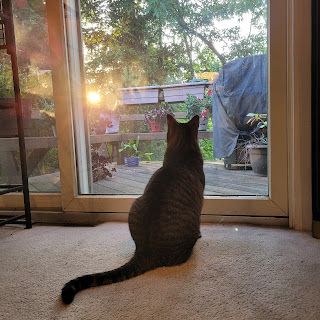I first began baking bread about 50 years ago, having been given a white bread recipe by the wife of a fellow Army bandsman. For years, I baked bread often, but I eventually got out of the habit. In the past couple of years, however, I got back into baking and began experimenting with different styles of bread.
Some time ago, I bought a bag of rye flour without having a specific idea of what I was going to do with it. (Finding rye flour in a supermarket was rare back then, so I grabbed it when I had the chance. My own experience suggests that rye flour is still a bit hard to find.) I began experimenting with breads containing rye, though not actually recognizable as rye bread.
The recipe below has been developed over many batches (and bags of rye flour). It produces tasty, slightly sweet bread. It has become my everyday bread recipe.
A couple of notes on the recipe: Active dry yeast can be substituted for instant dry yeast. The baking time was determined in an oven whose temperature regulation was quite accurate. The time may need to be adjusted for other ovens.
Lionel Deimel’s Multigrain Bread
Ingredients:
| 4¼ c (655 g) | Unbleached white bread flour |
| 1⅔ c (208 g) | Rye flour |
| ⅔ c (83 g) | Whole wheat flour |
| 1½ Tbs (16 g) | 2 packets instant dry yeast |
| 2 c | Water between 100⁰F and 115⁰F |
| ¼ c | Granulated sugar |
| ⅓ c | Dark brown sugar |
| ⅓ c | Crisco |
| 2 tsp | Salt |
Instructions:
| 1. | Mix all flours well in a large bowl. | |
| 2. | Dissolve yeast in water in a second bowl. | |
| 3. | When yeast is dissolved (or at least well distributed), add granulated sugar, brown sugar, Crisco, salt, and 3½ c of the flour mixture. | |
| 4. | Mix all ingredients until the Crisco is blended in. | |
| 5. | Add another 2½ c of the flour mixture and mix well. | |
| 6. | Flour work surface with some of the remaining flour mixture. | |
| 7. | Turn out dough on work surface and knead until it is smooth and elastic and form it into a ball. Add more flour mixture as necessary to prevent the dough from being sticky. | |
| 8. | Place dough in a large bowl coated with Crisco. Turn the dough to coat it all over with Crisco. | |
| 9. | Cover the bowl with waxed paper and a towel, and let the dough rise in a warm, draft-free location until it is doubled in size, about 80 min. | |
| 10. | Coat two loaf pans with Crisco and set aside. | |
| 11. | Flour work surface lightly with remaining flour, adding bread flour if necessary. | |
| 12. | Divide the dough into two equal-weight pieces. | |
| 13. | Knead each piece to make a smooth ball and roll the dough into a rectangle with the long side slightly longer than the loaf pan. Roll up dough tightly from the long side, folding the ends under. Smooth the edge with the seam as much as possible and place the dough in a prepared loaf pan, seam side down. | |
| 14. | Cover the loaf pans with waxed paper coated in butter and a towel. Let dough rise in a warm, draft-free location for approximately 70 minutes. | |
| 15. | Preheat oven to 400⁰F. | |
| 16. | Bake loaves in the oven for 37 min. | |
| 17. | Turn out loaves onto cooling racks. Let bread rest for at least 10 min. before slicing. |
 |
| The finished product |





